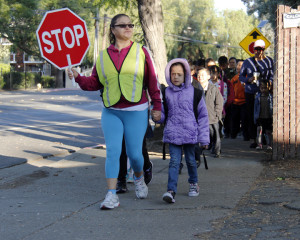When Rosa Juarez walks her daughter and niece to school on busy Detroit Avenue in Concord, Calif. each morning, she sports a bright yellow safety vest and carries a hand-held stop sign. The safety gear identifies her as a parent volunteer and part of the Meadow Homes Elementary School Walking School Bus program. At least a dozen other children and 2 other parent volunteers from her neighborhood walk closely behind her, forming a walking bus to school.

Every school day, eight walking school buses make their way to and from Meadow Homes, with about 120 to 140 children taking part. In the morning, parent volunteers who live furthest from the school start the walking bus, and they’re joined by children and other parent volunteers along the way. In the afternoon, volunteers start at the school, and the process repeats in reverse.
For Juarez and other parent volunteers, one big benefit of the program is both parents and children are getting more exercise.
“Diabetes runs in my family, so I know I need to stay active,” Juarez explained through a Spanish translator. “By walking to school, both my daughter and I have lost weight.”
One Program, Many Benefits
Kaiser Permanente Community Benefit supports the Meadow Homes walking school bus and others like it across California through Kaiser Permanente Healthy Eating Active Living (HEAL) Zone grants. The HEAL Zone grants support creating community environments where people can find nutritious food and get physical activity.

“Ultimately, this work is about obesity prevention,” said Kathryn Boyle, project manager, Kaiser Permanente Northern California Community Benefit. “The more we’re able to get people out and walking and eating in a healthy way, the more we can decrease rates of obesity and the chronic diseases that come with it.”
Ana Villalobos said walking school buses also reduce car traffic around schools and help make school communities safer. Villalobos works for the nonprofit group Monument Impact and is the area’s HEAL Zone manager. She launched the walking school bus at Meadow Homes and at two other area schools.
“Before the program, children were not walking to school because parents didn’t feel it was safe,” she said. “Many parents work, so it was easier to drop their children off in the car, but the traffic was horrible.”
Villalobos and parents at Meadow Homes were part of a grassroots community effort that secured a $2.2-million transportation grant that will make walking to the school even safer in the near future. The grant will pay for projects such as extending sidewalks in areas where there’s no safe place to walk and installing stoplights and bike lanes.
Creating Community
With more than 900 children attending Meadow Homes, the scene as children arrive at school can be a bit chaotic. But the school’s principal said the walking school bus program is making a difference.
“I think it’s wonderful,” Mary-Louise Newling said. “There’s more of an adult presence in the morning, so adults help children cross the street safely, and they help to direct the car traffic as well.”
And there’s one other important benefit. Villalobos said the program is helping to bring the school together.
“The kids are meeting new friends, and the parent volunteers feel wanted, needed and part of the community.”




